Looking for the perfect touring skis? Here’s the deal: Most of your backcountry skiing time (about 90%) is spent climbing uphill. That means heavy, long skis can drain your energy fast. Shorter, lighter skis, like Snowfeet’s WALKSKI or NORDIC models, are changing the game by being easier to carry, simpler to use, and more agile on tricky terrain.
Key Takeaways:
- Short skis (under 63 inches) are easier to maneuver, lighter, and less tiring for uphill climbs.
- Long skis (over 67 inches) offer stability and speed but can feel bulky and harder to control in tight spaces.
- Snowfeet options (like WALKSKI and NORDIC) are compact, lightweight, and compatible with regular winter boots - no need for specialized gear.
- Best for beginners and pros alike: Short skis are forgiving for newbies and precise for advanced skiers in technical areas.
Whether you’re weaving through trees, tackling steep slopes, or looking for a hassle-free setup, shorter skis can make your adventures smoother and more fun. Let’s break it down further!
How to Choose Alpine Touring Skis
Short Skis vs. Long Skis: Understanding Your Options
For years, the skiing world has leaned on the idea that longer skis are the gold standard for performance. But that’s not the full story, especially when you're navigating the twists, turns, and challenges of varied mountain terrain. Short skis are shaking things up, offering a fresh take with their focus on maneuverability and user-friendly design.
"The primary distinction between short and long backcountry skis lies in their length. Short skis, typically less than 160 cm, are known for their enhanced maneuverability. On the other hand, long skis, generally measuring 170 cm and above, prioritize stability and improved glide on diverse terrain."
– Snowfeet Team
Short skis, measuring under 63 inches, stand apart from traditional touring skis from brands like Rossignol, Atomic, and Head, which often stretch beyond 67 inches. That extra length can make a world of difference when you're tackling tight switchbacks or lugging gear up steep inclines.
How Short Skis Are Changing Mountain Adventures
Short skis are transforming the backcountry experience in exciting ways. Take the Snowfeet* WALKSKI Backcountry Touring Skis, for example - they measure just about 39 inches, and the NORDIC Cross-country Skate Skis are even shorter at roughly 35 inches. These designs are all about agility, responding to terrain changes with minimal effort.
This nimbleness is especially handy when you're weaving through trees or making quick adjustments on unpredictable snow. Short skis let you move with precision and ease, without requiring dramatic shifts in your body position.
Another big perk? Weight. Short skis are much lighter, which means less fatigue during long climbs and easier transport. Mini skis range from as short as 17 inches to about 47 inches, with some Snowfeet* models as compact as 20 inches. That’s a far cry from the bulk of traditional 67+ inch skis. Their lightweight and compact design make them perfect for adventurers looking for a hassle-free, backcountry-ready option.
"Shorter is better for kick turns, tight stuff and weird snow."
– Benneke10
Short skis also have a forgiving nature that makes them ideal for beginners. They’re easier to control, allowing newcomers to focus on their technique and enjoy the ride without battling heavy, cumbersome equipment.
Still, while short skis shine in many areas, long skis hold their ground in certain scenarios.
Problems with Long Touring Skis
Traditional long skis from brands like Head, Elan, and Atomic have their downsides, especially in backcountry settings. The most obvious issue? They can feel bulky and unwieldy.
"Long skis are too clunky and heavy. In a snowpark or on a slope, you will have more fun with short skis, which are easy to control and fun to slide."
– Snowfeet Team
Transporting and storing long skis can also be a headache. They often require roof racks or specialized bags, whereas compact short skis - like some Snowfeet* models - can fit neatly into a standard backpack.
In tight terrain, long skis can be a real challenge. Picture trying to navigate a narrow couloir or pulling off a kick turn on a steep slope with 70-inch skis. It’s not just exhausting - it can be downright risky. Long skis simply can’t match the freedom and flexibility that short skis bring to these situations.
Then there’s the matter of energy. Long skis are heavier, making uphill climbs harder and leaving you more drained as the day wears on. While they do provide better stability at high speeds on open terrain, most backcountry skiing happens at moderate speeds and across mixed conditions. In those scenarios, maneuverability takes the win every time.
"With short skis, turning becomes a breeze... shorter skis give you more control and agility."
– Snowfeet Team
What to Consider When Choosing Touring Skis
Choosing the right touring skis can make or break your backcountry experience. It’s not just about picking what looks cool - your skis need to match your adventure goals. Let’s break it down.
Terrain Type: Picking Skis for Your Adventure
The terrain you plan to ski on plays a huge role in what kind of skis you should get. The wrong choice can turn an exciting day into a frustrating one.
Ski width matters. For most ski touring trips, skis around 95mm underfoot are often recommended. But, shorter skis can bring a new level of versatility, especially when you’re dealing with mixed terrain.
If you’re heading into open powder fields, wider skis are traditionally the go-to because they float better in deep snow. That said, shorter options like Snowfeet* skis are easier to handle in tight spots, where longer skis from brands like Rossignol or Atomic can feel clunky.
Short skis shine in mixed conditions. Planning to hit powder, groomed trails, and variable snow all in one trip? Moderate-width skis are your best bet. For example, the Snowfeet* WALKSKI Backcountry Touring Skis, at about 39 inches long, let you handle changing terrain without the bulk of traditional long skis.
For tight trails or tree runs, shorter skis are a game-changer. While traditional backcountry skis from brands like Head or Elan work well in open spaces, they can be a struggle in narrow couloirs or dense forests, where quick turns are key.
Now, let’s talk about how your skill level should guide your choice.
Skill Level: Matching Skis to Your Ability
Your experience level plays a big part in choosing the right skis. Snowfeet* skis offer something for everyone, no matter where you are on your skiing journey.
Beginners love the simplicity. Long, heavy skis can feel overwhelming for newcomers. Snowfeet* skis, with their compact design, let beginners focus on learning the basics without being bogged down by unwieldy gear. This helps build confidence faster.
Intermediate skiers will appreciate how Snowfeet* models make it easier to tackle more challenging terrain. The skis’ responsiveness and control help you level up your skills quickly.
Even advanced skiers might be surprised by the agility and control shorter skis offer. While longer skis provide stability, shorter ones can be a better choice for technical backcountry routes, where quick reactions and precision are essential.
Now, let’s dive into why weight and portability matter so much in the backcountry.
Weight and Portability: Light Gear, Easier Days
When you’re climbing thousands of vertical feet, every ounce counts. This is where traditional touring skis often feel like a burden.
A super light ski can weigh around 2.2 lbs, while average touring skis are closer to 3.3 lbs. High-end skimo racing setups can go as low as 1.65 lbs for skis and bindings combined, with boots weighing around 1.1 lbs.
Snowfeet* skis take it even further - being shorter and lighter than most traditional options. Less weight means less fatigue, so you can focus on enjoying the climb and the descent.
Portability isn’t just about weight. Traditional skis often need roof racks, oversized bags, or other awkward solutions for transport. Snowfeet* skis, on the other hand, can fit into a standard backpack. This makes them perfect for remote trailheads or frequent travelers. Plus, storing them at home is a breeze.
Boot Compatibility: Keep It Simple
One of the standout features of Snowfeet* skis is their compatibility with standard winter shoes or snowboard boots. This means you don’t need to invest in specialized ski boots, saving you time, money, and hassle. Fewer moving parts also mean less maintenance, so you can focus on the fun part - hitting the slopes.
Snowfeet* vs. Traditional Touring Skis Comparison
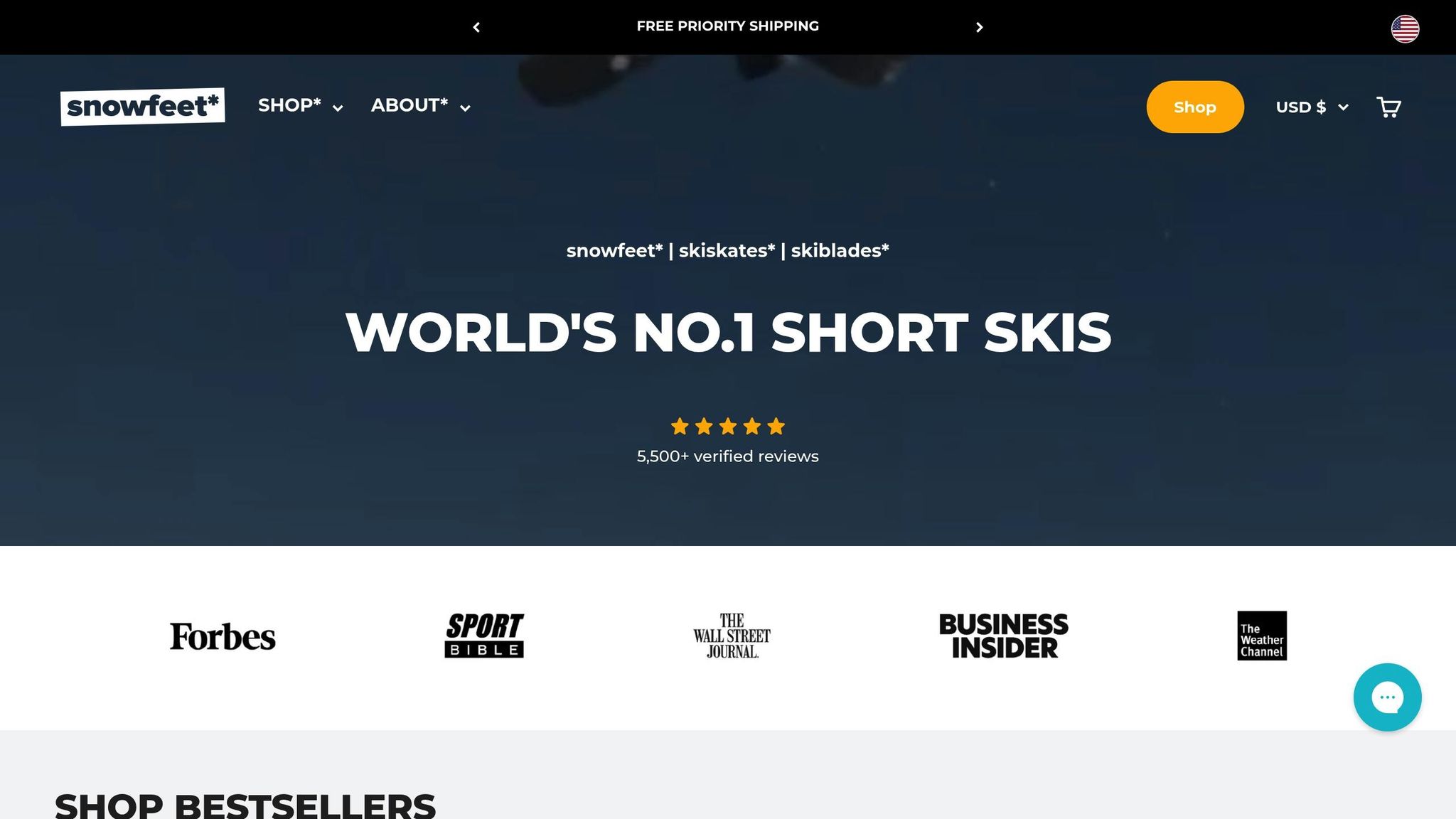
Let’s break down how Snowfeet* stacks up against traditional touring skis from brands like Rossignol, Atomic, Head, or Elan. Spoiler alert: the differences are pretty striking.
Traditional touring skis are great for open terrain, but they come with some baggage - literally. They’re heavier, require special ski boots, and often need extra transportation solutions. Not exactly ideal for last-minute adventures.
Snowfeet*, on the other hand, flips the script. Their compact, lightweight design means you can toss them in a backpack and go - no bulky gear, no complicated setup.
"Light, compact, and ready to go. Snowfeet fit your gear, your car, and your lifestyle." – snowfeetstore.com
Another big win? The learning curve. Thanks to their shorter length, Snowfeet* make balancing and steering a breeze. That means less fatigue and more fun.
"Long enough to ski, short enough to skate. Easy to Learn and Use. Strap in and ride – no lessons needed." – snowfeetstore.com
Side-by-Side Comparison: Snowfeet* vs. Traditional Skis
| Feature | Snowfeet* Short Skis | Traditional Touring Skis (Rossignol, Atomic, Head, Elan) |
|---|---|---|
| Length | 35–47 inches (90–120 cm) | 63–75 inches (160–190 cm) |
| Weight | Lightweight design | Heavier construction |
| Boot Compatibility | Works with winter or snowboard boots | Requires specialized ski boots |
| Transport | Fits in a backpack | Often needs extra transportation solutions |
| Learning Curve | Ready to use right away | Typically requires lessons and practice |
| Maneuverability | Super responsive in tight spaces | Can feel clunky in technical terrain |
| Storage | Fits in a closet | Needs significant storage space |
| Setup Time | Quick strap-in and go | Involves more complex binding adjustments |
This comparison makes it clear why Snowfeet* is a favorite for backcountry explorers looking for agility and ease.
Now, while traditional skis shine in wide-open powder fields, their length can be a real challenge in tight spots like narrow couloirs, dense forests, or variable terrain where quick direction changes are key.
"In general, short skis provide more fun and freedom of movement, they are playful, responsive, lightweight on your feet, easier to stop, and for many skiers easier to ride as opposed to cumbersome long skis." – snowfeetstore.com
Safety is another area where Snowfeet* stands out. Their lighter weight and shorter length mean falls are less harsh and put less strain on your joints.
Plus, with Snowfeet*, you can use your existing winter or snowboard boots - no need to splurge on specialized touring boots. And because they’re so portable, you can head out on a whim without worrying about lugging around oversized gear. It’s all about making your mountain adventures simpler and more fun.
sbb-itb-17ade95
Best Snowfeet* Touring Skis for 2025
Now that you’re familiar with why short skis are a game-changer, let’s dive into the best Snowfeet* options for your next mountain adventure. Each model is crafted to handle different terrains and skiing styles, all while being lightweight and easy to carry. Here are the top picks for 2025.
Snowfeet* WALKSKI Backcountry Touring Skis (100 cm)
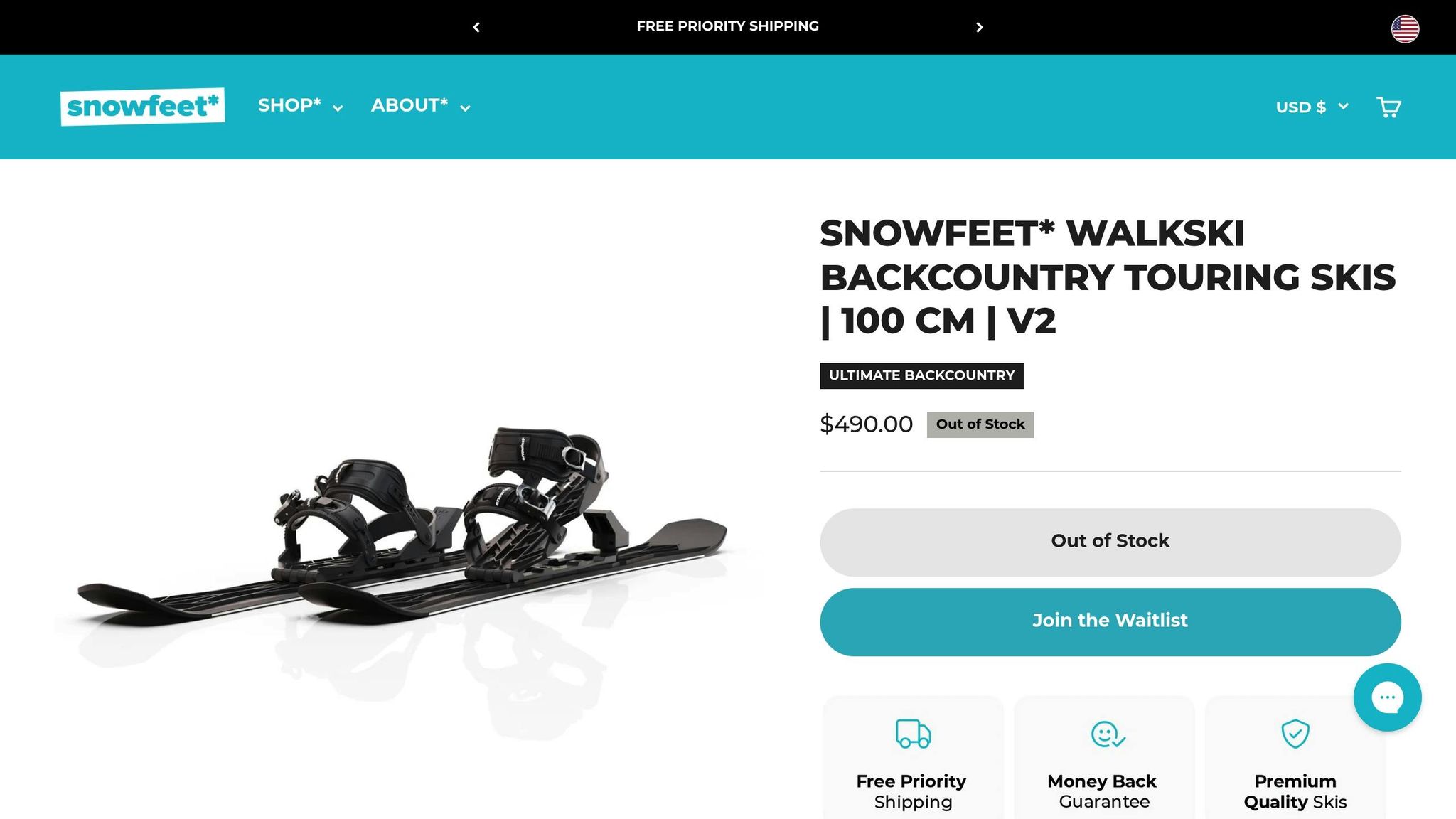
Measuring 39 inches (100 cm), the WALKSKI strikes a great balance between performance and portability. It features a universal free heel binding with 4 adjustable positions, making it perfect for both uphill climbs and downhill runs. Plus, the built-in climbing skins mean you can leave extra gear at home. Designed for backcountry explorers who value lightweight setups, the WALKSKI is a steal at $490 - especially when compared to traditional touring setups that can set you back around $2,200. It’s compatible with hiking, trekking, and winter boots with flexible soles, making it a versatile choice for outdoor enthusiasts.
Snowfeet* NORDIC Cross-country Skate Skis (90 cm)
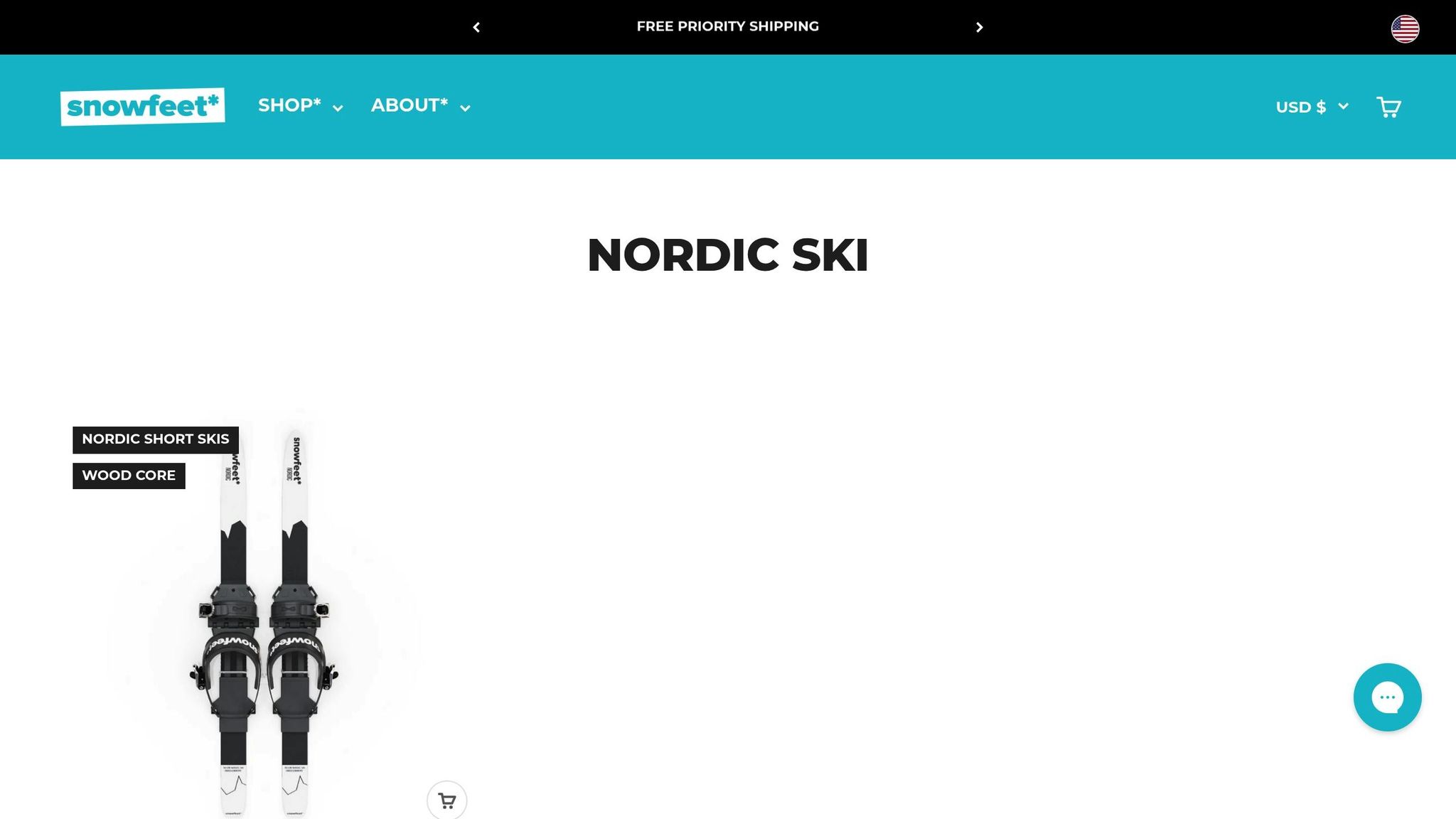
For cross-country fans, the NORDIC is a standout option. At 35 inches (90 cm), these skis are designed for skate-style skiing on both groomed and ungroomed trails. With metal edges for added control and a waxless base (Fishscales) that can still be glide-waxed, they’re practical and easy to maintain. Priced at $350, they’re an affordable choice that works with shoe sizes 6–13 US (38–47 EU) and pairs with regular winter shoes or pro cross-country bindings.
Users have been raving about the NORDIC. Martina MacLean shared:
"For someone who hasn't been on XC skis in 40 years, purchasing these shorter Nordic Snowfeet has been very exciting!"
Paul DeCecco added:
"A really nice surprise in a 'small' package... We both love the size and our increased flexibility to move as we need due to the size."
With a perfect 5.0/5 rating based on 7 reviews, the NORDIC is also praised for being lightweight and easy on the knees, making it a great option for those with joint concerns.
Other Snowfeet* Models Worth Checking Out
If you’re looking for more options, Snowfeet* has a variety of models to suit different needs and budgets:
- Snowfeet* Mini Ski Skates (44 cm): At just $390, these 17-inch skates are perfect for sledding hills and hiking trails. They boast a perfect 5.0/5 rating.
- Snowfeet* Ski Skates (50 cm): Priced at $250 with a 4.9/5 rating, these are great for all-around mountain activities.
- Snowfeet* Skiblades (65 cm): Starting at $450, these 26-inch skis shine in carving, snowpark landings, and powder skiing, with a 5.0/5 rating.
- Snowfeet* 99 cm Skiblades: At $490, these 39-inch skis are ideal for resort skiing and snowpark fun, also rated 5.0/5.
Snowfeet* continues to impress with their lightweight, portable designs, all of which are compatible with standard winter footwear.
Tips for Using and Maintaining Short Touring Skis
Now that we've explored the top Snowfeet* models, let’s dive into some practical advice to help you get the most out of your short touring skis. From picking the right size to keeping them in great shape, here’s what you need to know.
How to Choose the Right Length for Your Needs
The length of your skis can make or break your experience, so it’s worth getting this right. Your choice should factor in your height, skill level, and how you plan to use them.
- Beginners: Go for skis that are shorter than your height - aiming for around nose-height is a good rule of thumb.
- Experienced skiers: You might prefer skis that match or slightly exceed your height for added versatility.
For instance, if you’re 5'8" (173 cm), the WALKSKI at 39 inches (100 cm) or the NORDIC at 35 inches (90 cm) could be great fits. Shorter skis are easier to handle in tight spots, like weaving through trees or making quick kick turns. On the other hand, longer skis are better for carrying extra weight, gaining speed, or floating over powder. If you’re just starting out, or skiing in dense terrain, it’s smart to size down.
Once you’ve nailed the right length, it’s time to set up your gear properly.
Setting Up Your Gear for Best Results
The WALKSKI comes with a universal free heel binding featuring four adjustable positions. This gives you flexibility that many traditional setups from brands like Atomic or Rossignol don’t offer.
- Bindings: Adjust them to fit your boot size snugly. This is crucial for comfort and performance.
- Poles: Use adjustable poles that reach your armpits for balance. Shorten them for uphill climbs and lengthen them for descents, as this is especially important with shorter skis.
- Climbing skins: The WALKSKI includes built-in climbing skins, saving you the hassle of dealing with separate adhesive skins - a common feature of traditional touring skis.
A proper setup can make all the difference, so take the time to fine-tune your gear before hitting the slopes.
Keeping Your Skis in Top Condition
Snowfeet* skis are designed to be low-maintenance, thanks to their waxless base (Fishscales). But even with minimal upkeep, a little care goes a long way.
- Inspect bindings: Before each trip, check for loose screws or worn straps. Adjustable bindings experience more movement, so regular inspections help avoid surprises on the mountain.
- Clean after use: Wipe down the bases and bindings, especially if they’ve been exposed to salt or road chemicals, which can cause corrosion.
- Storage: Keep your skis in a dry spot away from direct sunlight. Their compact size makes storage easy - they’ll fit in most closets or gear rooms without the hassle of finding space for long skis.
For added performance in icy conditions, you can apply a light layer of all-temperature glide wax to the glide zones on either side of the fishscale pattern. It’s a quick and easy way to boost your ride.
- Edge care: Check the metal edges (like those on the NORDIC) for rust or nicks. Light rust is fine, but deeper rust or significant damage should be smoothed out with a file.
- Replace worn straps: Straps are essential for keeping your skis secure. If they’re looking worn, swap them out. Snowfeet* offers replacement straps and accessories, so it’s a simple fix.
Conclusion: Upgrade Your Mountain Adventures with Snowfeet*
Snowfeet* is shaking up the world of backcountry skiing, offering a fresh alternative to the long, bulky skis from brands like Rossignol, Atomic, and Head. Unlike traditional setups that require specialized boots and plenty of storage space, Snowfeet* focuses on simplicity and portability - perfect for modern adventurers.
With over 5,500 users singing its praises, Snowfeet* is compact enough to fit in your backpack and works seamlessly with your winter boots. No extra gear, no hassle. As Vanessa from the UK put it:
"Easily one of the best purchases I have ever made to date." – Vanessa, UK
Designed for everyone from kids to seniors (ages 5 to 105!), Snowfeet* makes hitting the slopes easier than ever. Whether you're tackling hiking trails or carving down ski slopes, its user-friendly design lets you jump right into the action with confidence.
Why let heavy gear and steep learning curves slow you down? Snowfeet* offers a compact and versatile way to spend more time enjoying the mountains and less time fussing with equipment. It’s time to upgrade your adventures and rediscover the joy of the great outdoors!
FAQs
How do I choose the right touring ski length for my height and skill level?
How to Choose the Right Touring Ski Length
Picking the right touring ski length comes down to a mix of your height, skill level, and the kind of adventure you’re planning. A good rule of thumb? Touring skis should usually fall somewhere between your chin and the top of your head. For most people, skis that are 5–15 cm shorter than their height are easier to manage, especially when tackling climbs or navigating tight, tricky turns.
If you’re just starting out or focusing more on uphill travel, go for shorter skis - about 5–10 cm below your height. They’ll give you better control and make maneuvering much easier. On the other hand, if you’re an experienced skier aiming for stability and better downhill performance, you might prefer skis that are closer to, or even slightly above, your height.
For those looking for something versatile and easy to use, Snowfeet’s compact skis are a standout option. Take the 100 cm Snowfeet* WALKSKI Backcountry Touring Skis, for example. These shorter skis are a fresh alternative to the longer, traditional designs from brands like Rossignol or Atomic. Their lightweight and portable design make them incredibly agile - perfect for modern mountain adventures in 2025.
What makes Snowfeet short skis better than traditional long touring skis for backcountry adventures?
Snowfeet short skis are a game-changer for anyone who loves exploring the backcountry. Thanks to their lightweight and compact design, they make uphill climbs less exhausting and way more enjoyable. Unlike traditional long touring skis, these are super easy to carry, so you can focus on the adventure instead of the gear.
One of the coolest things about Snowfeet is that they work with regular winter boots. That means no need to invest in pricey, specialized touring boots or bindings. Talk about saving both money and hassle!
Their small size and portability also make them perfect for tight or tricky terrain. Whether you're navigating narrow trails or packing for a trip, these skis are incredibly convenient. For most adventurers, Snowfeet offer a more practical and flexible alternative to traditional skis, letting you enjoy the slopes without overcomplicating things.
Can I use Snowfeet skis with any winter boots, and do they need special setup or maintenance?
Snowfeet skis are built to pair effortlessly with nearly any type of winter boots - whether you're rocking standard winter boots or snowboard boots. This flexibility makes them a super convenient choice for anyone, from beginners to seasoned snow enthusiasts.
What sets Snowfeet skis apart from traditional skis is their simplicity. There’s no need for a complicated setup or special upkeep. Plus, their lightweight, portable design means you can grab them and hit the slopes right away. No fuss, no extra gear - just pure mountain fun.

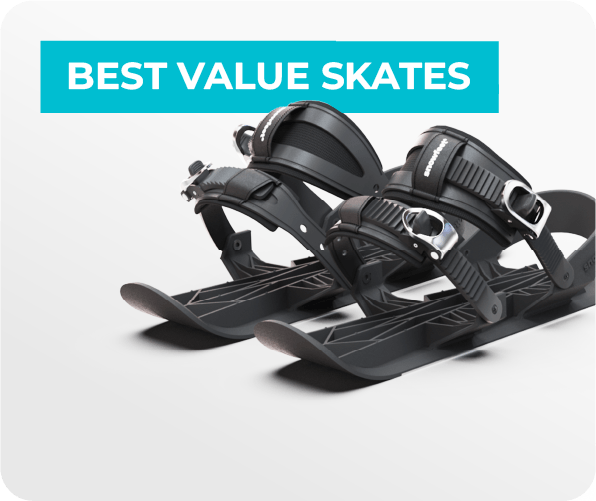



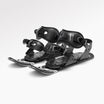
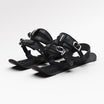
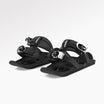
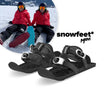

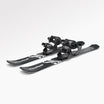

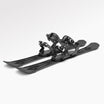
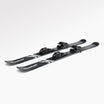






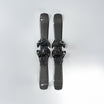
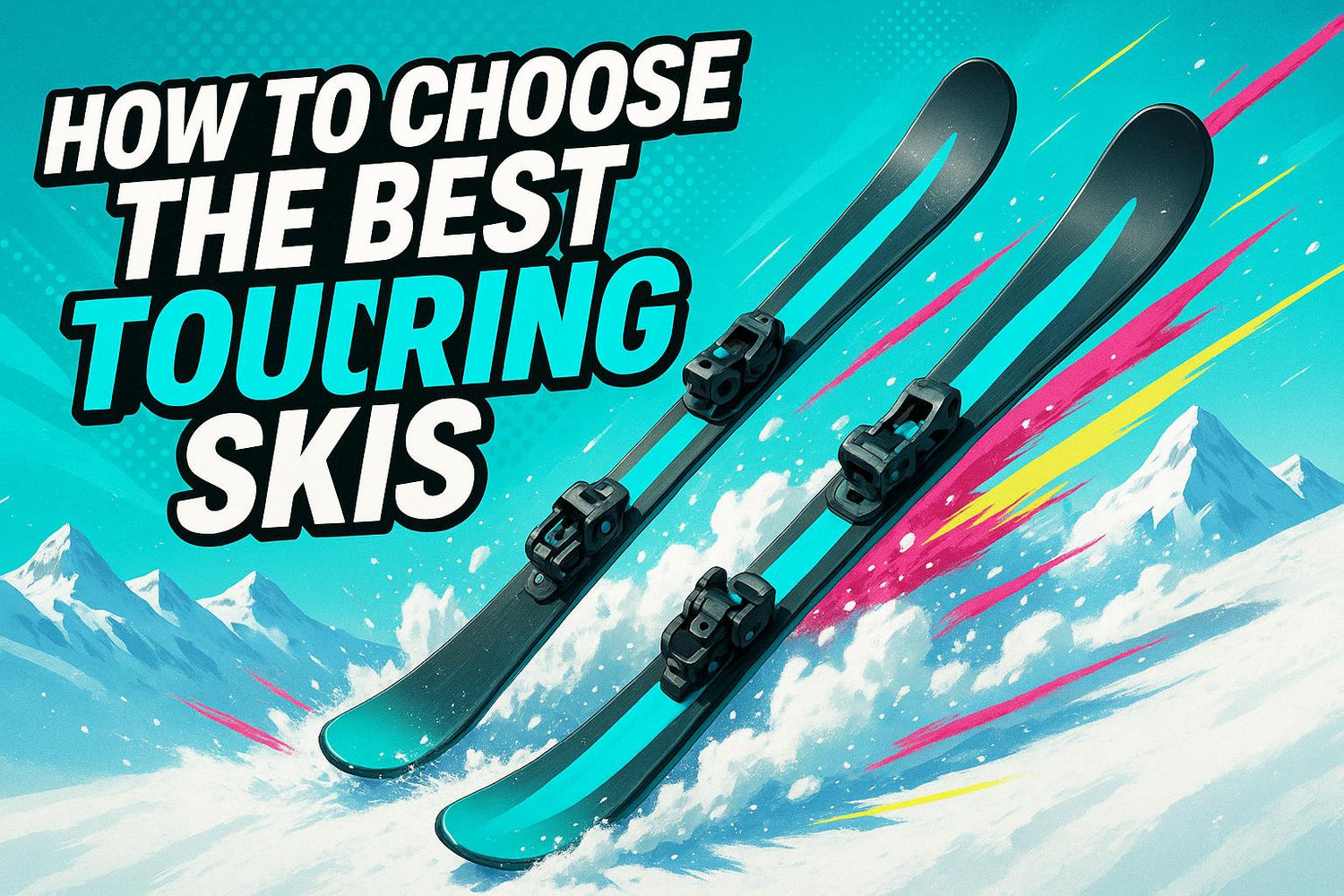
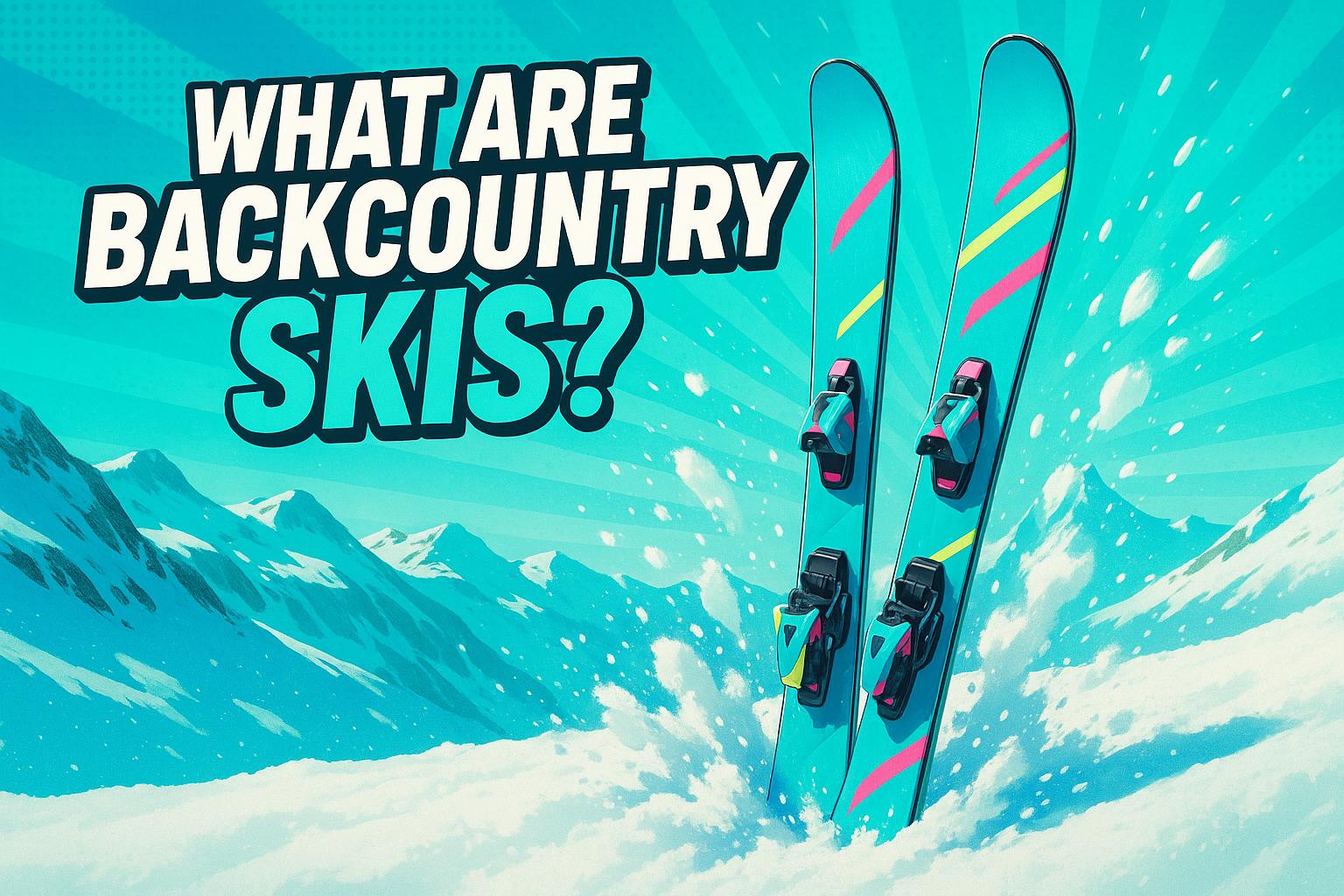
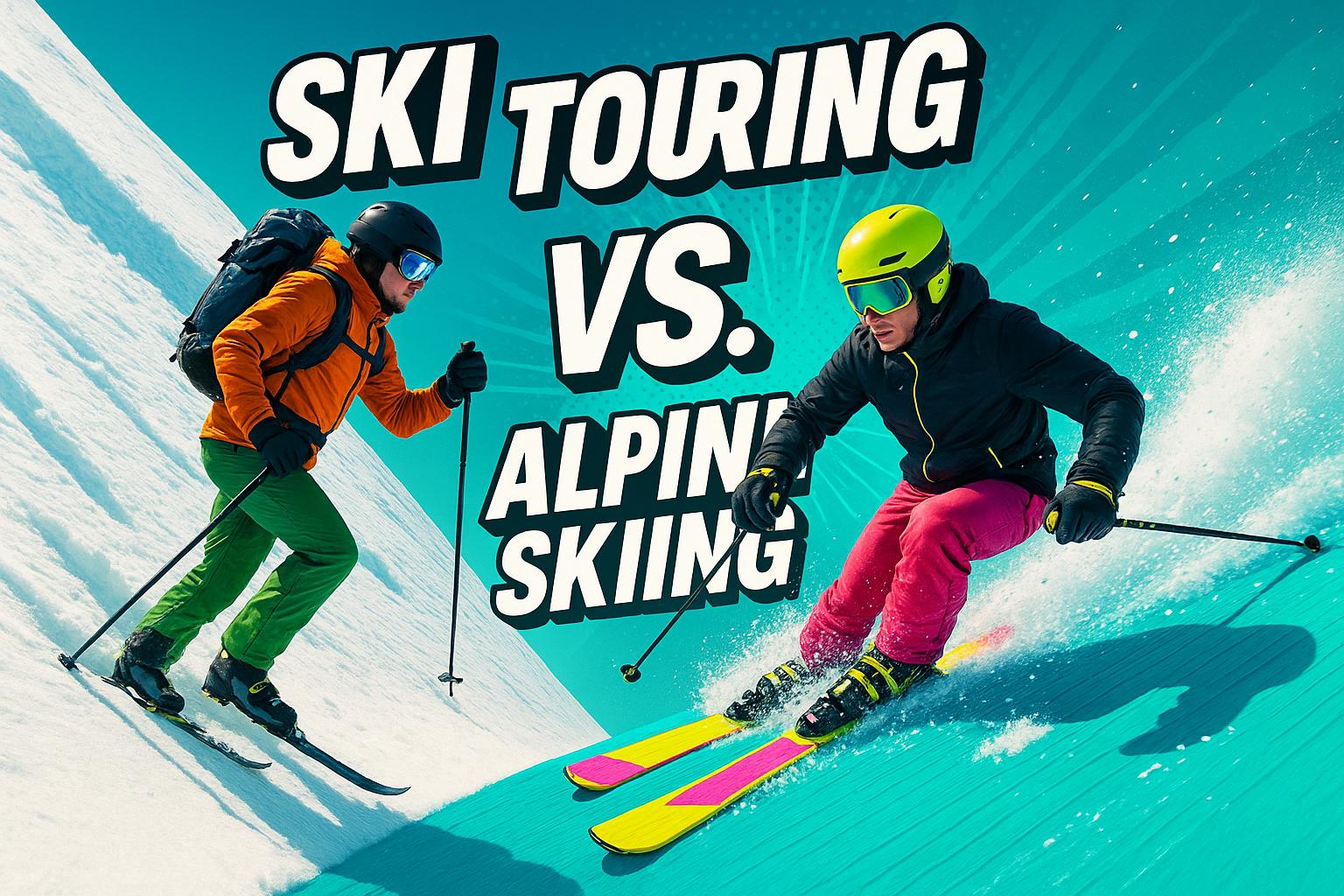
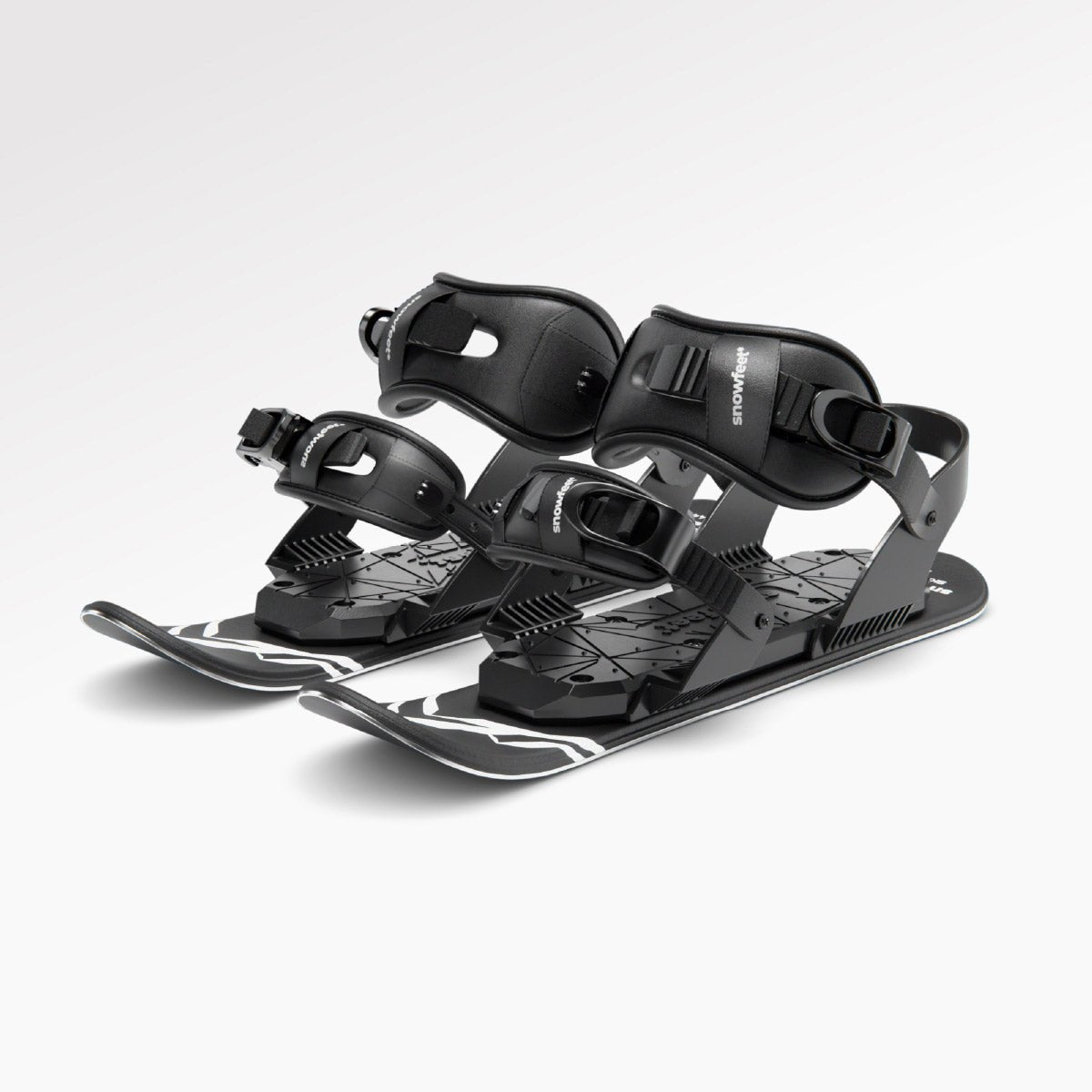
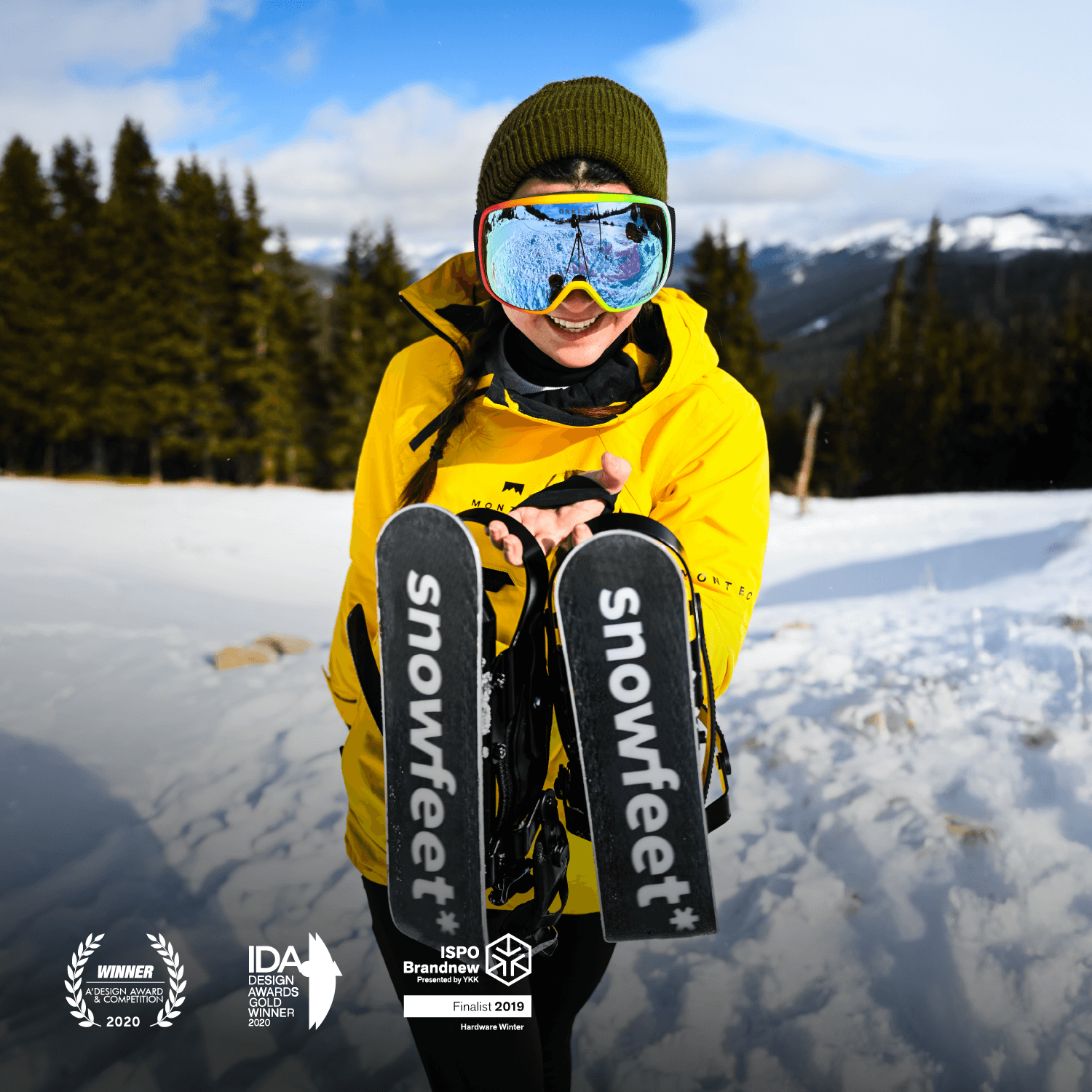
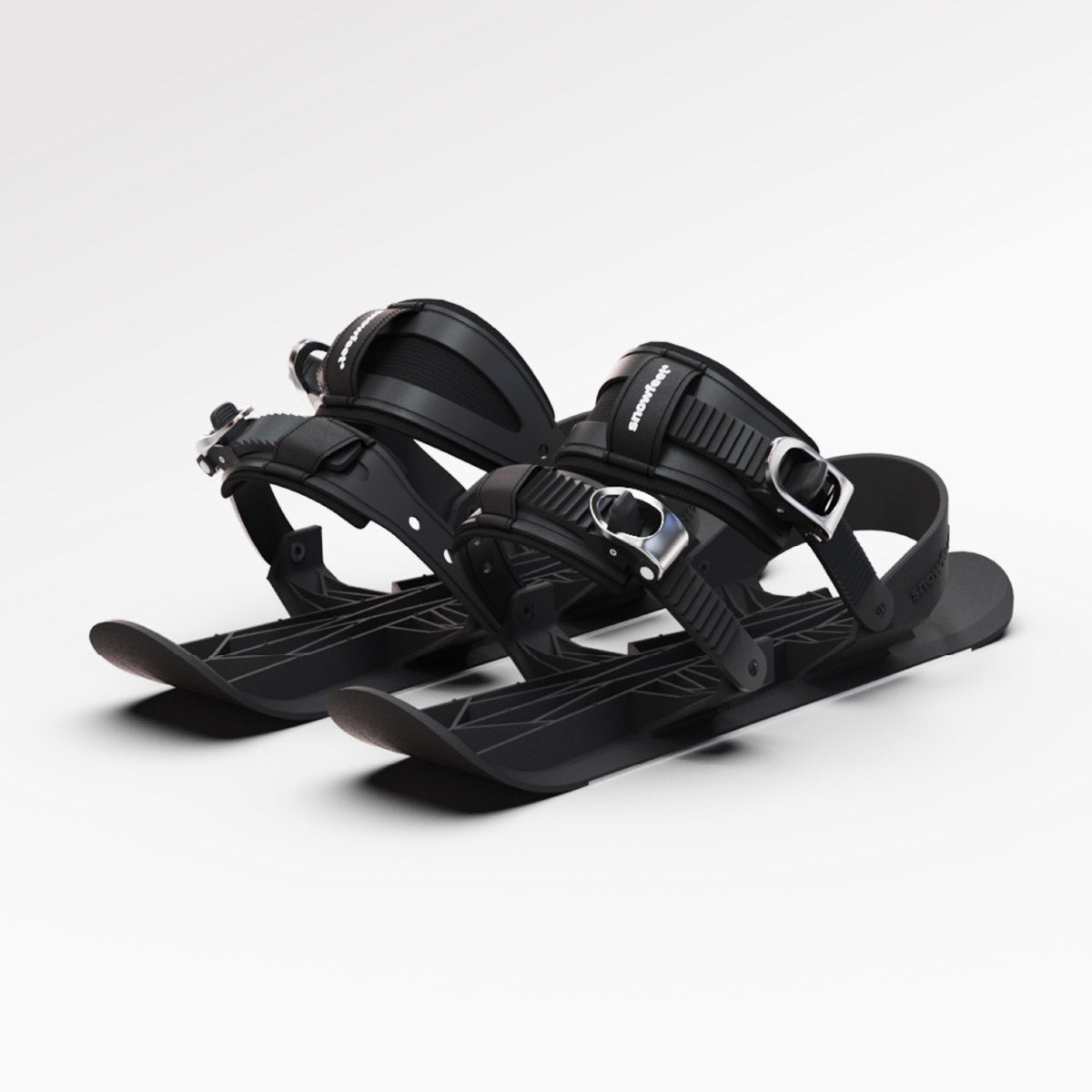

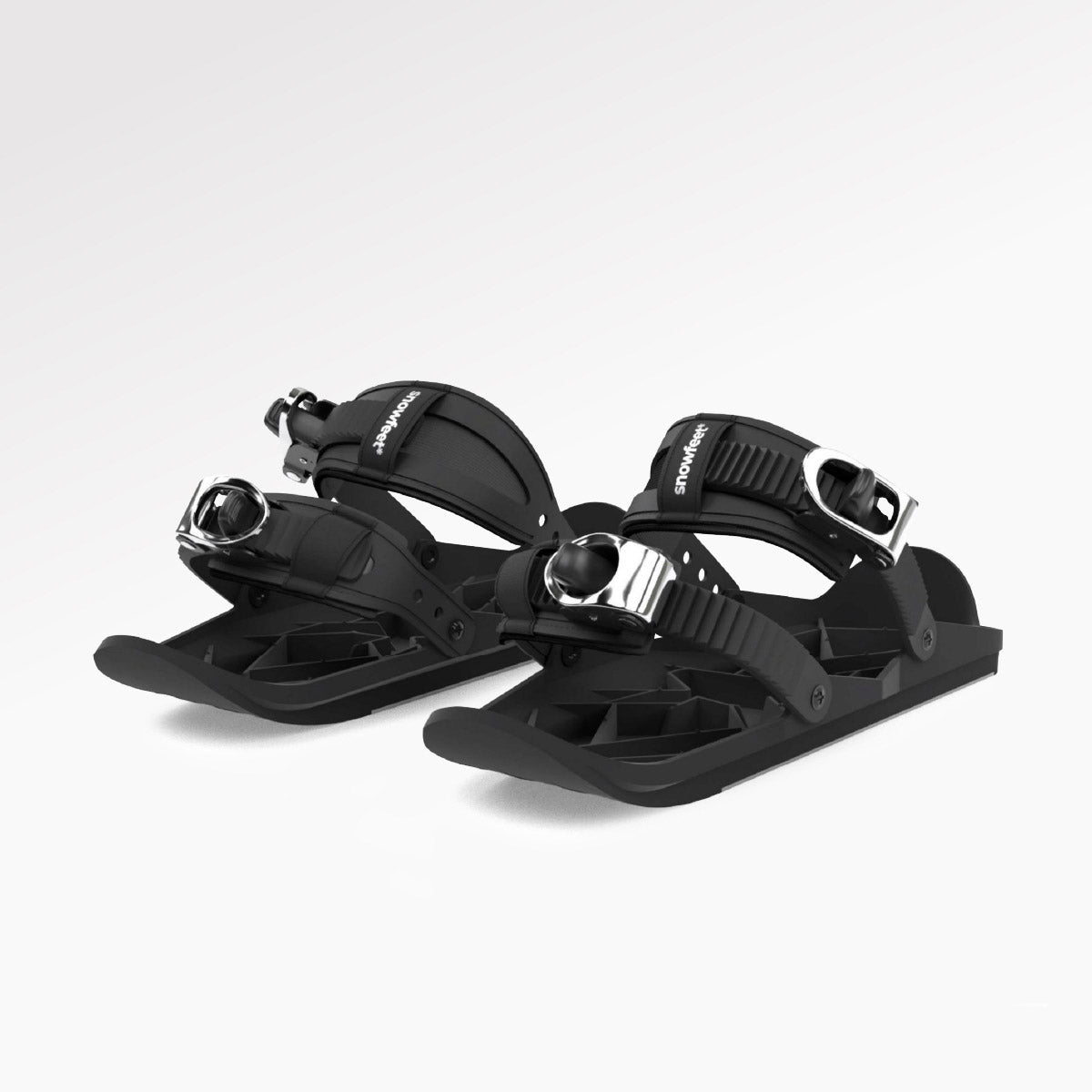
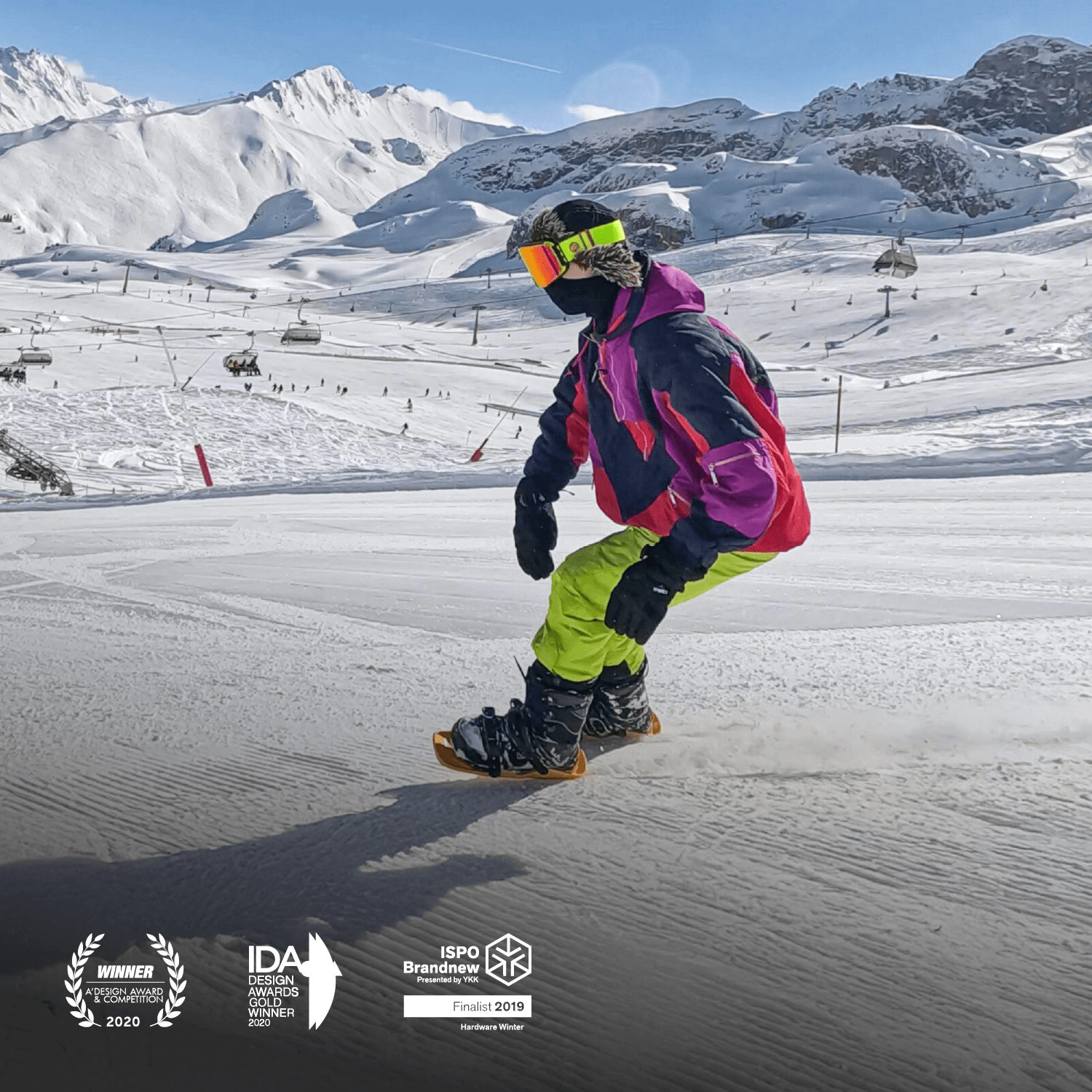


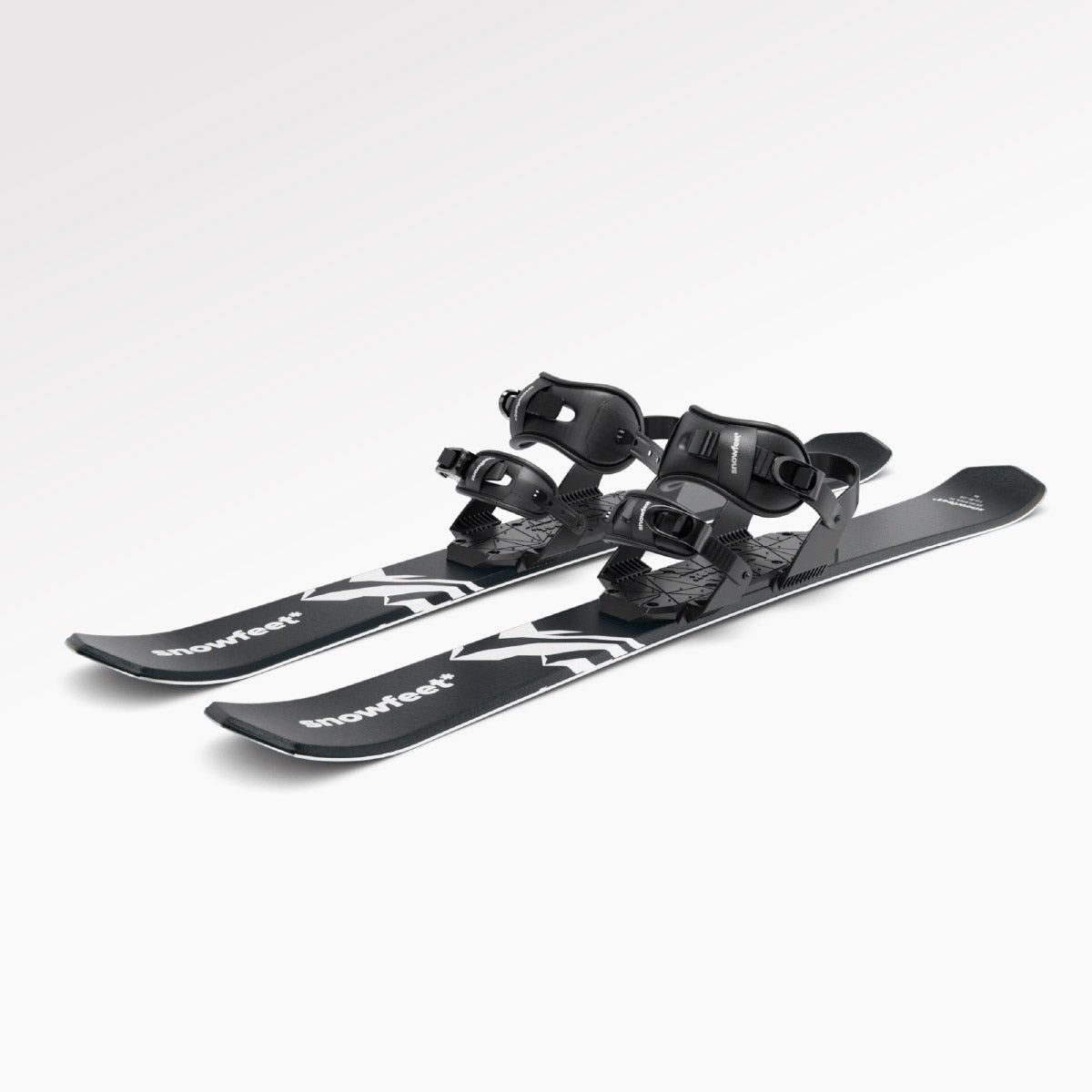
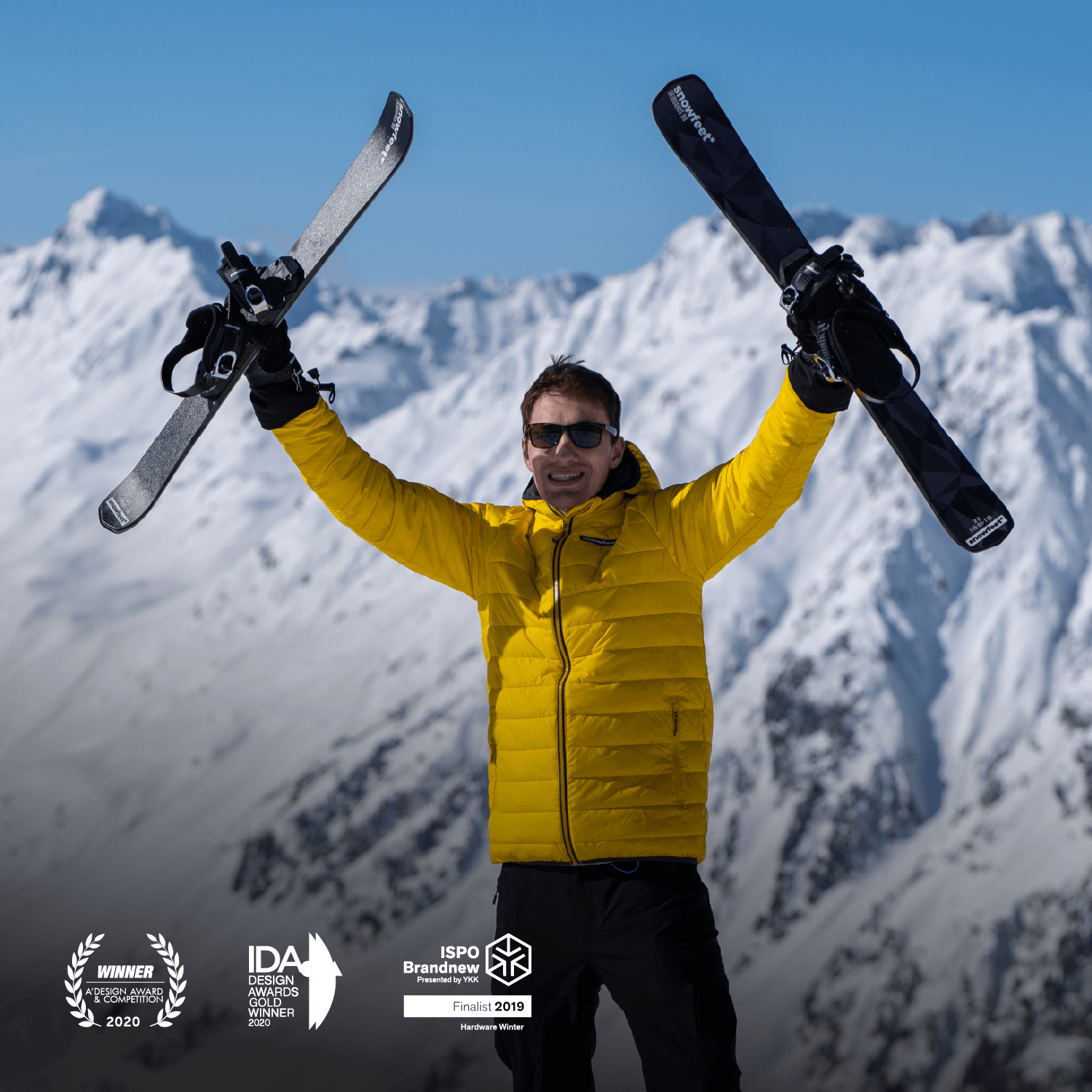
Leave a comment
This site is protected by hCaptcha and the hCaptcha Privacy Policy and Terms of Service apply.